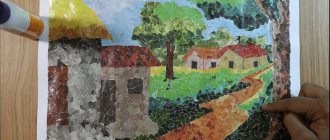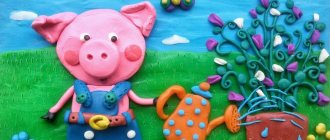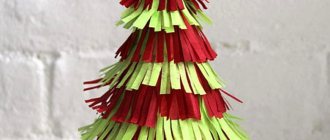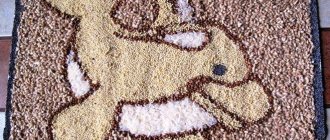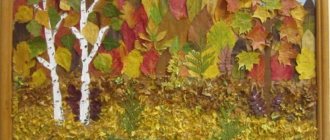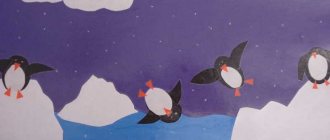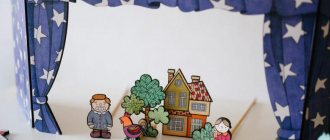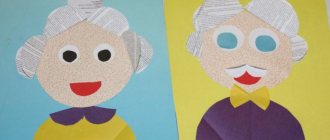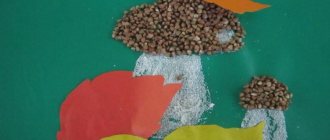Types of applications
Before you start learning how to make beautiful appliqués with your own hands, you should understand what types of this technique exist.
- Mosaic applique - first the contours of the image are drawn, then parts of geometric shapes and different sizes are glued inside it.
- If you twist colored paper into a spiral, the technique is called quilling.
- For symmetrical applique, before cutting out the part, the paper blank is folded in half.
- A multi-layer applique is one that is created from parts of different sizes, small ones are glued onto large ones.
- If you trace the palm and use this figure as a base, you will get a palm applique.
Owl creation technique
- Take cardboard - it will be the base.
- Glue a twig cut from colored paper.
- Now paint the background with paints, you can paint with your fingers.
- Glue clouds, moon and other background elements as you wish.
- Using the templates, trace the outline of the owl on the branch with a pencil.
- Tear off pieces of paper and glue them inside the outline.
- Make a second layer on top of the first.
- You can draw the eyes and beak with felt-tip pens or make them out of colored paper and glue them on.
Interesting ideas and application patterns on the topic “Birds” in the preparatory group
Children are very fond of fantasy works, for example, interpretations on the theme “Fairytale Bird” (photo 4, 8, 14, 18). They like to choose colors and shapes of feathers according to their wishes. In this regard, the work “Firebird” (photo 8) is interesting, where the feather on the tail is represented in the form of a cascade of droplets. The “Bird of Happiness” applique looks unusually effective (photo 18): the bird is all shiny and shimmers due to the bright candy wrappers from the endowment, the decor made of lace fabric looks elegant. Photo 14 - collective work, each child painted a feather to his or her taste, and together they made the tail of a magical bird. Fantasy works also include the composition “Festive outfit for an owl” (photo 17).
Three-dimensional compositions, which we see in photos 1, 5, 6, 7, 13, 15, 20, always look beautiful. A similar effect is achieved by partially gluing the silhouette of a bird, as well as using the technique of applique from strips, applique from lumps of napkins or pieces of torn colored paper.
A charming craft is a cockerel made from dry leaves (photo 2); this application is usually done in the fall. Another rooster is also made of non-traditional material - fabric (photo 16), the variety of patch patterns gives it a bright look.
Children will probably be happy to start making crafts “Sovunya” - a character from the cartoon “Smeshariki”; it is made of simple parts, but looks quite original.
Preschoolers also love group creativity. In this regard, the works in photos 1, 10, 11, 12, 13, 14, 19 are interesting (the children created the composition as a whole group or worked in a subgroup). Such activities, without a doubt, unite the guys, force them to be more attentive to each other, and jointly enjoy the results of their work. The basis of such compositions is usually prepared in advance by the teacher. This could be a tree with many branches on which the birds will be located, or a painted feeder where the birds will happily dine. Oh, where water is depicted in an unusual way - using blue and red strips of paper that convey reflections.
Photo: domestic and wild birds - rooster, cranes, firebird, swan, owl, duckling, etc.
Work in a subgroup Application from dry leaves Application Application
Applique made from paper strips Volumetric applique Applique
Application
Subject composition
Teamwork
Teamwork Teamwork Teamwork
Teamwork
Teamwork
Fabric applique Applique Applique using candy wrappers and lace Work in a subgroup Volumetric applique
Subject application
Templates
Part templates
Part templates
Silhouette cutting template
Part templates
Part templates
Firebird
The process of creating such a craft perfectly develops the imagination, because the character is magical and very bright.
- To make the head and body, cut out a ten-centimeter square piece from colored paper.
- Form a square into a triangle and bend along the larger side.
- Now expand the square - it is divided into four sectors.
- To get the body of the bird, glue both edges overlapping.
- The belly is the larger side, and the smaller side is the back.
- To create a chic ponytail, cut nine nine-centimeter strips - curl them or leave them straight.
- Glue three stripes to the back, six will serve as material for making wings also on the back.
- You can also make both the tail and wings using the palm technique.
- You can cut out eyes and other small details from colored paper or draw them.
- Attach the bird to the background on a branch of colored paper, decorate the background by painting it and gluing parts from colored paper.
Abstract of GCD for application in the preparatory group of preschool educational institutions. Bullfinch
Summary of direct educational activities on the application “Bullfinch” in the preparatory group.
Author: Bogdanova Nadezhda Gennadievna, teacher at the Children's Preschool Educational Institution “DS No. 10”, Kopeysk.
Description of the material: I offer you a summary of direct educational activities for children of the preparatory group (6-7 years old) on an application on the topic: “Bullfinches.” This material will be useful for teachers of the preparatory group. Unconventional napkin appliqué techniques. Direction of activity: “Artistic and aesthetic development.” Goal: Creating a three-dimensional applique of a bullfinch. Objectives: - develop creative abilities; - develop fine motor skills and perseverance; - cultivate accuracy when performing work; - cultivate aesthetic taste, joy from creating your work; - cultivate love and respect for nature. Material: - sample; - blank mugs made of red paper napkins. - a simple pencil; - scissors; - PVA glue; — bullfinch templates. Preliminary work: Conversations about birds, drawing birds;
reading stories about birds. Progress of GCD
1. Organizational moment. Educator: Guys, listen to the poem “Bullfinches.” Paws are getting cold in the cold near the pine and spruce trees. What a miracle The apples are ripe on the birch tree. I’ll come closer to her and I can’t believe my eyes. A flock of scarlet bullfinches stuck around the tree. Author: T. Shorygina 2. A teacher’s story about bullfinches. Guys, do any of you know what a bullfinch looks like? What does it eat? Where does it winter? How does a person take care of him? Why did the bullfinch come to us for the winter? Now listen to the story about bullfinches. “Nature becomes even more beautiful in winter, when handsome bullfinches appear on snow-covered trees and bushes. They are called so because they appear in our area with the first snow. The bullfinch is found within the Chelyabinsk region as a sedentary and nomadic species. Lives in coniferous forests. Bullfinches have a bright pink chest (pinkish-brown in females), a gray back (brownish-gray in females), and a black “cap.” The bullfinch feeds on seeds of maple, lilac, rowan, plant buds, hawthorn fruits, etc. In winter, the number of bullfinches increases due to birds migrating from the North. - The bullfinch is considered the first herald of winter - the bullfinches have arrived, which means the real winter has begun. Educator: -Let's listen to how the bullfinch sings. (Recording of a bullfinch singing.) Educator: - Tell me, how does a bullfinch sing? What does his singing sound like? (Children's answers). Now you know what bullfinches are and where they live. 3. Explanation of the material. Educator : - Guys, I suggest you look at a sample of work. Educator . Look carefully at our bullfinch. Name the body parts of a bird. (The bullfinch has a beak, head, wings, tail, paws) Educator : What parts of the bullfinch’s body are black? (The bullfinch has black wings, a black head) Educator: What color is the bullfinch’s body? (red) But before we make our bullfinch. Let's rest a little 4. Physics lesson “A nimble tit is jumping” A nimble tit is jumping, (Jumping in place on two legs.) She can’t sit still, (Jumping in place on the left leg.) Jump-jump, jump-jump, (Jumping in place on the right leg.) Spun like a top. (Spinning in place.) So she sat down for a minute, (Squatted down.) Scratched her chest with her beak, (Standed up, tilted her head left and right.) And from the path to the fence, (Jumping in place on the left leg.) Tiri - tiri, (Jumping in place on the right leg.) Shadow-shadow-shadow! (Jumping in place on two legs.) 5. Finger gymnastics. -How many birds flew to our feeder? We'll tell you. Two tits, a sparrow, Six goldfinches and bullfinches, A woodpecker in motley feathers. There were enough grains for everyone. 6. Children begin making applique. While the application is being performed, the melody of the winter forest sounds 7. Result. Tell me, what did we do today? You did a good job today, well done, what beautiful bullfinches we got.
We recommend watching:
Paper bullfinches using quilling technique for children. Master class with photo Summary of a lesson on appliqué in the preparatory group. Oak Summary of GCD for application in the preparatory group of kindergarten on the topic: Animals of the North Lesson on application on the topic Autumn in kindergarten. Preparatory group
Similar articles:
Application. Bullfinches on a branch
Crafts made from dry leaves
To create a firebird from dry leaves, prepare dry leaves, a glue gun, paint, and a sheet of cardboard.
- For the background, paint cardboard or use colored cardboard.
- Spread the paper and carefully arrange the leaves, and then color them.
- Now dry the leaves. Apply hot glue to the cardboard and glue colorful leaves.
- To do this, there must be an adhesive layer on the cardboard sheet, as well as spot-applied glue on the leaves.
- First, form the shape of a tail, then a larger leaf that stands out in shade - this will be the body of the firebird.
- Paws and eyes can be made from colored paper or cardboard.
- The magic bird is ready!
other methods
Tear-off - the picture is assembled from small multi-colored pieces. This technique trains perseverance because it takes much longer than the others. Additionally, fine motor skills are developed, since working with small elements is very painstaking.
Volumetric - the nest is often depicted on a paper plate or papier-mâché craft. The materials from which the product will be made can be very diverse: cotton wool, feathers, threads, dry grass, felt, paper, etc. It all depends on the child’s capabilities and imagination.
The combinations are countless. The miraculous embodiment is practiced not only in kindergartens, but also by art history professionals.
Migratory birds
Materials you will need:
- Sheet of cardboard,
- colored paper,
- And also scissors
- Paints and glue.
Operating procedure:
- A piece of cardboard is the sky.
- Color it or get a colored one.
- Cut out clouds from white cardboard and glue them to form a background.
- Draw and cut out the birds and then glue them to the cardboard.
- Draw the details - eyes, feathers, beak, and also add trees and other elements as desired.
Chickens
In order to make a craft with the image of funny chickens or other poultry, take a sheet of colored cardboard, cotton pads, a brush with paints, as well as glue and plasticine.
- The entire cotton pad will play the role of the head, as well as the body of the bird; if you separate half of the disc, you will get wings or a tail. Pre-paint them with paints and then glue them to the cardboard.
- All other elements (paws, eyes, beak) can be made from plasticine.
- To create a goose or chicken, you need to make a printout with a picture of a bird, and also stock up on a piece of cotton wool and PVA glue.
- Roll cotton balls to fill the image.
- You can also add colors to your work - paint some elements if necessary, add details.
- This way you will get a bird with plumage, the effect of which is created by cotton wool.
Cockerel and hen
- Take a white sheet of paper, a brush with paints, images with a pre-printed chicken and cockerel, colored paper, napkins of different colors, and you can’t do without a hole punch, glue and scissors.
- Prepare your future background: for this you need to paint a white sheet of paper and draw on it the background elements that you come up with.
- Illustrate the earth as well as the sky in your work.
- You can use colored paper to create images of a house, fence and other details.
Now cut out the birds.
- You can move on to decorating the characters of the craft - cut out feathers from colored paper, twist lumps from a napkin, a hole punch will be useful for making confetti.
- Glue the resulting plumage, now you can glue the birds to the background.
- If you wish, you can create a large work in a group, which will include an entire poultry yard.
There are many techniques for creating applications with images of birds. Using those presented in this article, you will create unique paintings that will decorate your child’s room, and the process of creating this masterpiece will give him a lot of positive emotions.
Also, all these techniques can be safely used for classes in kindergarten, all of them will develop the imagination of children and teach them to be neat, and will give them experience in running their own small project.
Application “Birds on the branches” outline of a lesson on applique, modeling (middle group)
GCD applique “Birds on branches”.Teamwork (middle group)
Goal: - to teach children to make an application in the form of a bird; - consolidate the idea of their name, structural features, body shape, wings, tail, distinctive features of different types of birds; - to cultivate love and caring attitude towards birds; - strengthen the ability to carefully use glue; -develop fine motor skills of the fingers, the ability to listen and hear birds singing; -develop observation and attention; - practice correct sound pronunciation; develop a response to a verbal signal.
Equipment: template made of colored paper: body, wing, tail, beak; oilcloth, brushes, glue, napkins. Image of birds: tit, sparrow, woodpecker, swallow; image of a tree. Audio recording of birds singing. Toy steering wheel.
Progress of the lesson: -We go on a trip to a forest clearing. We'll go by car. How does he signal? (Children enter the group in which images of birds are pre-attached) -Listen, guys, who sings so beautifully? (Birds) -Where did they hide? Let's find them and see what kind of birds flew to us. This is a magpie. It is also called the white-sided magpie because its sides are white. This is a little sparrow. Nimble jumper. How does he tweet? Chick-chirp! -What kind of bird is this? In a red riding hood, he knocks and knocks on wood with his sharp beak. (Woodpecker). -And this is a titmouse - she has a yellow belly. All these birds live next to us both in winter and summer. - But this bird flew to us from the south. This is a swallow. It flies very quickly, catches midges, mosquitoes and other harmful insects. -Look, guys, what is this unusual bird? Where did she come from here? I think I know: this bird was made by children from another kindergarten and sent to see the world. Is it really beautiful? -Yes! - Do you want me to teach you how to make such beautiful birds? And when you do them, we will let them fly to other kindergartens to visit the children. -Let's first figure out what the bird will consist of. I will show, and you name the parts. - Head. -Which smoothly passes into the body. - Wing. (why do you need a wing?) -Tail. (why do you need a ponytail?) -Eye. (why do you need an eye?) -Beak. (why do you need a beak?) - Now show me quietly how birds fly? The birds flew, flew around and sat down quietly at the tables so as not to make noise in the forest clearing. -Look at what lies on the table in front of you. 1. A twig depicted on a leaf. 2. The body of your future bird. 3. Wing. 4. Tail. 5. Round little eye. - The first thing we do is put a twig in front of us. Then we smear the body with glue and “plant” the bird on a branch. The bird's head is at the top, and the tail will be at the bottom. Glue the wing and glue the tail. Then glue the eye and beak. -Our birds are ready, let's put them on a common tree, and they will sing clear songs for us. -Oh, how loudly the birds sang, what do they want? I think I know. They invite us to play the game “Sparrows and the Car.” (game) - What did you learn to do in the forest clearing? — Did you like our trip?
-It's time for us to return home: wave goodbye to the birds and
we get into the little car.

